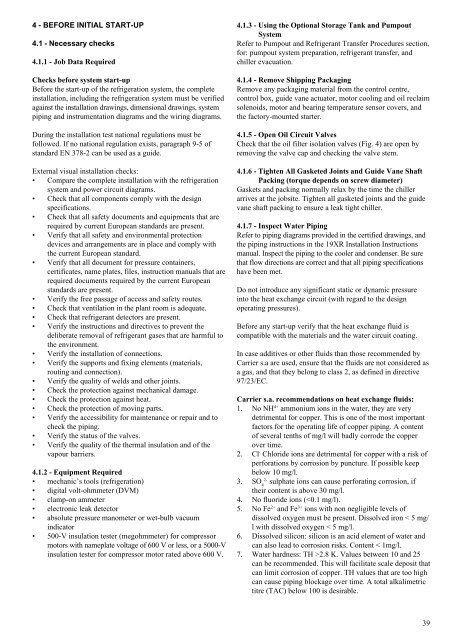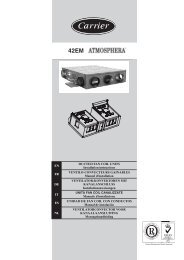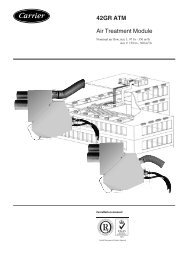19XR (PIC II) Hermetic Centrifugal Liquid Chillers 50 Hz - Carrier
19XR (PIC II) Hermetic Centrifugal Liquid Chillers 50 Hz - Carrier
19XR (PIC II) Hermetic Centrifugal Liquid Chillers 50 Hz - Carrier
You also want an ePaper? Increase the reach of your titles
YUMPU automatically turns print PDFs into web optimized ePapers that Google loves.
4 - BEFORE INITIAL START-UP<br />
4.1 - Necessary checks<br />
4.1.1 - Job Data Required<br />
Checks before system start-up<br />
Before the start-up of the refrigeration system, the complete<br />
installation, including the refrigeration system must be verified<br />
against the installation drawings, dimensional drawings, system<br />
piping and instrumentation diagrams and the wiring diagrams.<br />
During the installation test national regulations must be<br />
followed. If no national regulation exists, paragraph 9-5 of<br />
standard EN 378-2 can be used as a guide.<br />
External visual installation checks:<br />
Compare the complete installation with the refrigeration<br />
system and power circuit diagrams.<br />
Check that all components comply with the design<br />
specifications.<br />
Check that all safety documents and equipments that are<br />
required by current European standards are present.<br />
Verify that all safety and environmental protection<br />
devices and arrangements are in place and comply with<br />
the current European standard.<br />
Verify that all document for pressure containers,<br />
certificates, name plates, files, instruction manuals that are<br />
required documents required by the current European<br />
standards are present.<br />
Verify the free passage of access and safety routes.<br />
Check that ventilation in the plant room is adequate.<br />
Check that refrigerant detectors are present.<br />
Verify the instructions and directives to prevent the<br />
deliberate removal of refrigerant gases that are harmful to<br />
the environment.<br />
Verify the installation of connections.<br />
Verify the supports and fixing elements (materials,<br />
routing and connection).<br />
Verify the quality of welds and other joints.<br />
Check the protection against mechanical damage.<br />
Check the protection against heat.<br />
Check the protection of moving parts.<br />
Verify the accessibility for maintenance or repair and to<br />
check the piping.<br />
Verify the status of the valves.<br />
Verify the quality of the thermal insulation and of the<br />
vapour barriers.<br />
4.1.2 - Equipment Required<br />
mechanic’s tools (refrigeration)<br />
digital volt-ohmmeter (DVM)<br />
clamp-on ammeter<br />
electronic leak detector<br />
absolute pressure manometer or wet-bulb vacuum<br />
indicator<br />
<strong>50</strong>0-V insulation tester (megohmmeter) for compressor<br />
motors with nameplate voltage of 600 V or less, or a <strong>50</strong>00-V<br />
insulation tester for compressor motor rated above 600 V.<br />
4.1.3 - Using the Optional Storage Tank and Pumpout<br />
System<br />
Refer to Pumpout and Refrigerant Transfer Procedures section,<br />
for: pumpout system preparation, refrigerant transfer, and<br />
chiller evacuation.<br />
4.1.4 - Remove Shipping Packaging<br />
Remove any packaging material from the control centre,<br />
control box, guide vane actuator, motor cooling and oil reclaim<br />
solenoids, motor and bearing temperature sensor covers, and<br />
the factory-mounted starter.<br />
4.1.5 - Open Oil Circuit Valves<br />
Check that the oil filter isolation valves (Fig. 4) are open by<br />
removing the valve cap and checking the valve stem.<br />
4.1.6 - Tighten All Gasketed Joints and Guide Vane Shaft<br />
Packing (torque depends on screw diameter)<br />
Gaskets and packing normally relax by the time the chiller<br />
arrives at the jobsite. Tighten all gasketed joints and the guide<br />
vane shaft packing to ensure a leak tight chiller.<br />
4.1.7 - Inspect Water Piping<br />
Refer to piping diagrams provided in the certified drawings, and<br />
the piping instructions in the <strong>19XR</strong> Installation Instructions<br />
manual. Inspect the piping to the cooler and condenser. Be sure<br />
that flow directions are correct and that all piping specifications<br />
have been met.<br />
Do not introduce any significant static or dynamic pressure<br />
into the heat exchange circuit (with regard to the design<br />
operating pressures).<br />
Before any start-up verify that the heat exchange fluid is<br />
compatible with the materials and the water circuit coating.<br />
In case additives or other fluids than those recommended by<br />
<strong>Carrier</strong> s.a are used, ensure that the fluids are not considered as<br />
a gas, and that they belong to class 2, as defined in directive<br />
97/23/EC.<br />
<strong>Carrier</strong> s.a. recommendations on heat exchange fluids:<br />
1. No NH4+ ammonium ions in the water, they are very<br />
detrimental for copper. This is one of the most important<br />
factors for the operating life of copper piping. A content<br />
of several tenths of mg/l will badly corrode the copper<br />
over time.<br />
2. Cl- Chloride ions are detrimental for copper with a risk of<br />
perforations by corrosion by puncture. If possible keep<br />
below 10 mg/l.<br />
2- 3. SO sulphate ions can cause perforating corrosion, if<br />
4<br />
their content is above 30 mg/l.<br />
4. No fluoride ions (2.8 K. Values between 10 and 25<br />
can be recommended. This will facilitate scale deposit that<br />
can limit corrosion of copper. TH values that are too high<br />
can cause piping blockage over time. A total alkalimetric<br />
titre (TAC) below 100 is desirable.<br />
39




